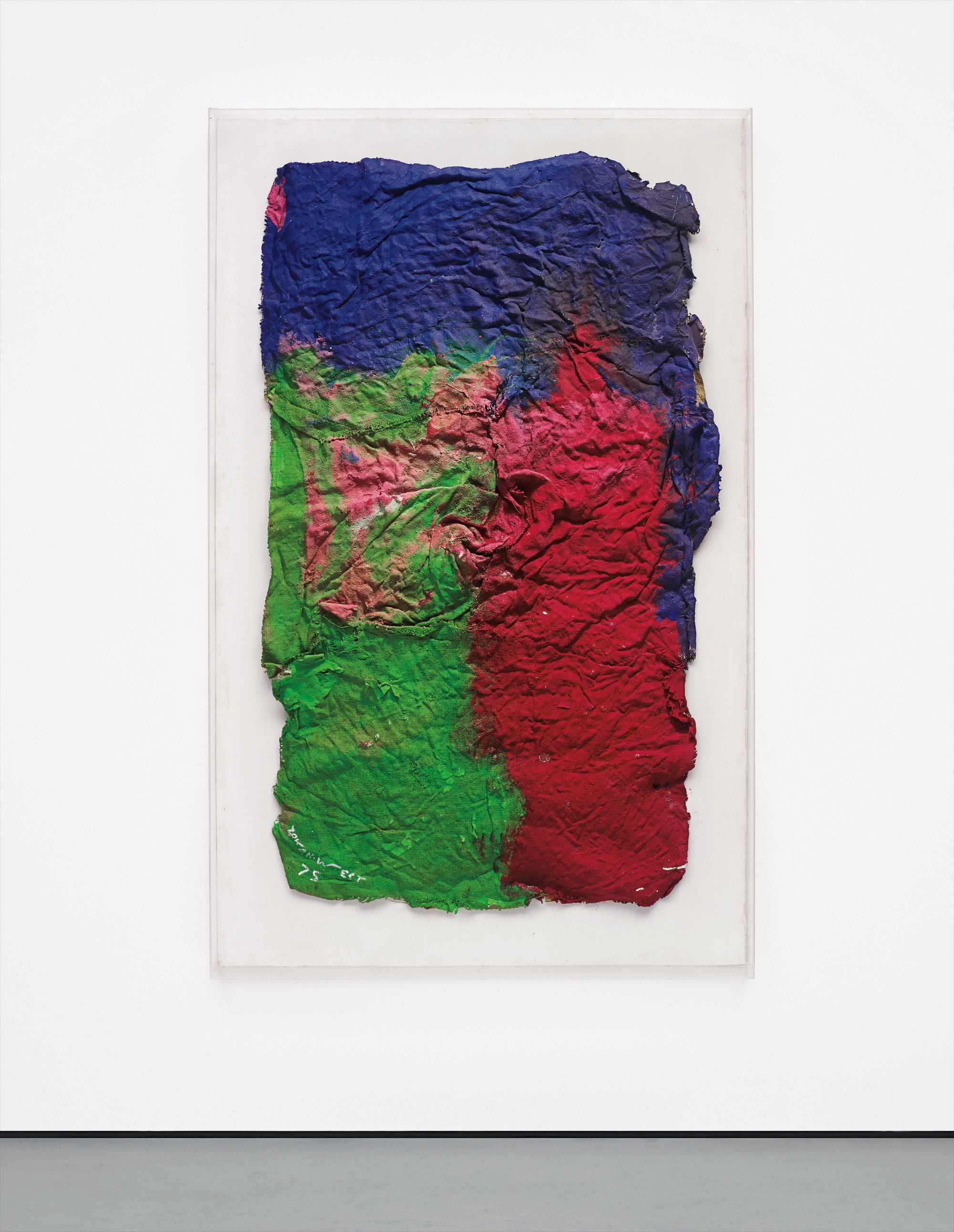

32
Franz West
o.T.
newspaper, acrylic on jute, laid on panel, in acrylic glass box frame
canvas 141 x 82.5 x 5 cm (55 1/2 x 32 1/2 x 1 7/8 in.)
frame 161 x 100.2 x 10.1 cm (63 3/8 x 39 1/2 x 3 7/8 in.)
frame 161 x 100.2 x 10.1 cm (63 3/8 x 39 1/2 x 3 7/8 in.)
Signed and dated 'ZOKAN.WEST 75' lower left. This work is accompanied by an Archival Confirmation document issued by the Franz West Privatstiftung Archiv.
Full-Cataloguing
Franz West came of age in an era of deep artistic angst. As a teenager in Vienna, West witnessed the passionately political performances of The Viennese Actionists, an influential group that dominated the city’s art scene after the Second World War. Alienated by their intensely existential and violent performances, West aptly described The Actionists’ work as Beeindruckungskunst—art made to impress. Although ultimately rejecting this dogmatic approach to art-making, West did embrace the performative aspects of their work, engaging viewers in playful dialogue.
His early experiments in artistic production came in the early 1970s, three years before enrolling in the Vienna Art Academy. These early works, which the artist called 'Adaptives,' were created as participatory objects. The innately interactive nature of West’s 'Adaptives' is revealed in their original German name—Paßstücke, originally translated as 'fitting pieces.' The sculptures are a bricolage of previous sculptures by the artist, which he continually reconfigured into a patchwork of plaster and papier mâché. West coined the term ‘Adaptives’ on the occasion of his first retrospective in 1994, finding an affinity with Viennese musicologist and scientist Oswald Weiner’s conception of the ‘bio-adaptor,’ a cybernetic suit that could intervene between body and mind. The 'Adaptives' were created to physically engage with the viewer—they were intended to be worn, touched and even painted. This iconoclastic approach to art practice continually reengaged the art object even after it has entered the setting of the museum: In a 2009 retrospective, labels told the exhibition-goer that works were to be touched, celebrating West’s thoughtful meditation into the entire conception of art. West explains: ‘early on I realised that the purely visual experience of an artwork was somehow insufficient. I wanted to go beyond the purely optical and include tactile qualities as well. My works aren't things one just looks at, but things that the viewer is invited to handle. There have been many theories of art that try to break down the border between art and the world, but I don't find such attempts to be particularly meaningful. Art remains art. I really see my work as quite compatible with the l'art pour l’art philosophy. One may think that I try to bring the art object out into the world since my works sometimes appear to have a practical function, but really it's the other way around: things in the world can, under certain special circumstances, enter the realm of art. And, in fact, once they have entered this realm they are art.'
Drawing inspiration from the psychoanalytic and philosophical writings of Sigmund Freud and Ludwig Wittgenstein, West cited the impact of these thinkers’ legacy on his work explaining that he is 'often i am awake after midnight and i am busy with the sculptures that I am working on. In a kind of half sleep, I have associations according to things I have read, seen and experienced…' (Franz West, 2010, Flash Art Interview). A 2009 installation in New York’s Central Park entitled The Ego and the Id further reveals the extent of Freud’s influence on the Viennese artist. His works are ambiguously open to physical and intellectual interpretation.
Difficult to categorise as simply painting or sculpture, the present lot epitomises the artist’s primal treatment of surface. Its undulating form and daring use of colour make it a unique example from his early period, combining elements often found in his ‘Adaptives’ with the palette of his more mature work. o.T., 1975 possesses a tactile quality of surface providing a literal allusion to the traditional notion of 'the artist’s touch,' lending an emotional quality to the work’s physical presence. West’s biomorphic forms, with their humorously lumpy surfaces, are deliberately unserious. The work entices viewers into West’s absurd and fantastical universe, providing visual delight as their eyes graze upon the awkward beauty of the work’s surface which as West describes is the ‘sculpture’s skin.’
Working in the footsteps of Abstract Expressionism, Pop and Minimalism, West’s artistic language is all his own—at once iconoclastic, irreverent and human. West eschewed the pretences of traditional sculptural conventions and materials, using humble materials like papier mâché, plaster, Styrofoam and jute rather than the more staid bronze or marble. Never striving for perfection, Franz West’s oeuvre recalls the aesthetic of Italian Arte Povera or American Pop masters Robert Rauschenberg and Claes Oldenburg, who transformed discarded or mundane materials in their sculpture. Unafraid of challenging artistic conventions, Franz West’s works are unpretentious and approachable. Renouned art critic Jerry Salz explains that West’s ‘career isn’t punk or being against: It is about finding the complex orders in disorder, the austerity in topsy-turviness, giving boisterous life to the id and permission to himself, his audiences, and his objects to create all the unrestrained elbow room needed. ‘(Jerry Saltz, 2012)